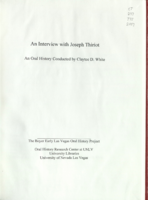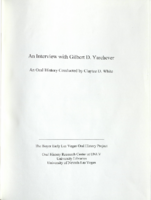Search the Special Collections and Archives Portal
Search Results
University of Nevada, Las Vegas Office of Media Relations Records
Identifier
Abstract
The University of Nevada, Las Vegas (UNLV) Office of Media Relations Records (1969-2003) primarily contain copies of UNLV faculty, staff, and alumni newsletters including
Archival Collection
David Donovan Collection on Hydrology and Geology
Identifier
Abstract
The David Donovan Collection on Hydrology and Geology (1911-2011) is comprised of the research collected by former Las Vegas Valley Water District employee, David Donovan, about groundwater, hydrology, minerals, and geology in Nevada, as well as the surrounding areas of California, Arizona, and Utah. Included are reports, professional papers, maps, and books.
Archival Collection
Jinetta Daniels oral history interview
Identifier
Abstract
Oral history interview with Jinetta Daniels conducted by Rani Dunn on November 30, 2014 for the African Americans in Las Vegas: a Collaborative Oral History Project. In this interview, Daniels talks about her upbringing in Mississippi and traveling to Las Vegas, Nevada by bus in 1962. She continues discussing her work as a maid at the Dunes Hotel, her membership in the Victory Baptist Church, and comments on various church and community leaders in the Westside. She also mentions her concerns about the closure of F Street in 2008 and her hopes for the revitalization of the Westside community.
Archival Collection
Steven Kalb oral history interview
Identifier
Abstract
Oral history interview with Steven Kalb conducted by Claytee D. White and Stefani Evans on January 05, 2017 for the Building Las Vegas Oral History Project. In this interview, Kalb discusses his early life in North Hollywood, California. He recalls moving to Las Vegas, Nevada in 1953, growing up in the Twin Lakes area, and recreational activities he participated in. Kalb talks about attending Arizona State University (ASU), studying construction engineering, and the formation of his father's company, George F. Kalb Construction. Kalb describes the first construction projects the company completed, forming Kalb Construction Company, and working on standalone projects. Lastly, Kalb discusses the future of the construction industry.
Archival Collection
John S. Park Roundtable Discussion #4: Community Change/Gentrification
Identifier
Abstract
Roundtable discussion with Michael Baker, Angela Kallus, Billy Logan, Jacqueline Maloy, Todd Jones, JoNell Thomas, Sarah Haggerty, Gregory S. Brown, and Dayvid Figler conducted by Claytee D. White on January 22, 2011 for the Voices of the Historic John S. Park Neighborhood Oral History Project. In this roundtable discussion, participants talk about their decision to move into the John S. Park neighborhood. The group describes the houses in the area during the early 2000s, changes in the house designs, and crimes in the area. Lastly, the participants talk about the gentrification of the area.
Archival Collection

Transcript of interview with Joseph Thiriot by Claytee White, August 10, 2000
Date
Archival Collection
Description
Joseph Thiriot is a longtime Las Vegas resident who served the community as an educator. He was born in 1906 in Provo, Utah; one of five sons bom to George W. and Elvira Thiriot. He has vivid memories of moving about, including living in Idaho where his father sold a typing machine , a forerunner to the typewriter. Eventually the family moved to a ranch in Pahranagat Valley, Nevada, where the limits of educational opportunities compelled his paients to send him back to Provo to finish his education while living with family there. Gaining a teaching certificate enabled Joseph to teach in rural Nevada. He completed his degree at the University of Utah and after meeting Las Vegas Superintendent Maude Frazier he relocated to Las Vegas to become a teacher. He reminisces about his life and the changes that have occurred over the years in Las Vegas.
Text

Interview with Joyce Anne (Reese) Parkhurst, November 27, 2004
Date
Archival Collection
Description
Text

Roadrunners Internationale A-12 session, October 5, 2005
Date
Archival Collection
Description
Text

Transcript of interview with Gilbert D. Yarchever by Claytee White, 2006
Date
Archival Collection
Description
Gilbert Yarchever was one of nine siblings, born and bred in Pittsburgh, Pennsylvania. He describes the way his mother?s family was granted the last name of ?Kurfeersf" by Emperor Franz Joseph (of Austria-Hungary), explains the Seder (the Jewish observation of the exodus of Hebrews from Egypt), and tells what it was like to survive the Depression. Gilbert describes the jobs he held after high school and the government examination he took that led to his lifetime of adventure and travel. He moved to Washington, D.C., in 1940 and kept himself busy working for the government and taking classes at George Washington University, as well as working part time at Hecht Department Store and as a freelance court reporter. Following the attack on Pearl Harbor in 1941, Gilbert was sent to Africa on a merchant ship, helped smuggle Jewish survivors into Jerusalem, and was assigned the task of negotiating with Arab sheikhs for laborers to build a road. In the years after that, he worked in Europe, Panama, Alaska, Japan, and Hawaii and describes many of the jobs he was responsible for and many of the individuals he met. He also married and had children, kept up with university classes whenever he could, and collected art objects and paintings. Following his retirement in 1977, Gilbert and his family came to Las Vegas and bought a condo in Regency Towers. He did some consulting work for a couple of years, and then he and his wife began traveling around the states and going abroad. He was involved with UNLV?s EXCEL program, the music department, and the Las Vegas Art Museum. (He and his second wife Edythe presented the first major exhibition on Holocaust art at the museum.) These days Gilbert often donates pieces from his art collection to churches, synagogues, and charitable organizations.
Gilbert Yarchever was in the Navy during World War II, helped smuggle Jewish refugees into Jerusalem, worked as a civil servant in many countries, and moved to Las Vegas in 1977. He helped found the EXCEL program at University of Nevada, Las Vegas and was an art collector with his wife, Edythe Katz-Yarchever.
Text
University of Nevada, Las Vegas School of Architecture Records
Identifier
Abstract
The University of Nevada, Las Vegas School of Architecture Records (1980-2011) include marketing material, curriculum development material, student letters to the Nevada legislative counsel, journals, newspaper clippings, and architectural drawing sets for the school building's construction.
Archival Collection
